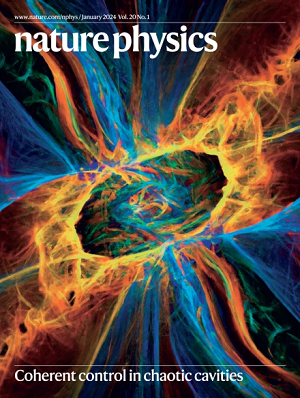Realizing coherently convertible dual-type qubits with the same ion species
IF 17.6
1区 物理与天体物理
Q1 PHYSICS, MULTIDISCIPLINARY
引用次数: 22
Abstract
Trapped ions constitute one of the most promising systems for implementing quantum computing and networking1,2. For large-scale ion-trap-based quantum computers and networks, it is critical to have two types of qubit: one for computation and storage, and another for auxiliary operations such as qubit detection3, sympathetic cooling4–7 and entanglement generation through photon links8,9. Although the two qubit types can be implemented using two different ion species3,10–13, this approach introduces substantial complexity into creating and controlling each qubit type14,15. Here we resolve these challenges by implementing two coherently convertible qubit types using one ion species. We encode the qubits into two pairs of clock states of the 171Yb+ ions, and achieve microsecond-level conversion rates between the two types with one-way fidelities of 99.5%. We further demonstrate that operations on one qubit type, including sympathetic laser cooling, single-qubit gates and qubit detection, have crosstalk errors less than 0.06% on the other type, which is below the best-known error threshold of ~1% for fault-tolerant quantum computing using the surface code1,16. Our work establishes the feasibility and advantages of using coherently convertible dual-type qubits with the same ion species for large-scale quantum computing and networking. Quantum computing with trapped ions requires qubits that can store and manipulate quantum information, and others that can be used for destructive incoherent operations. Different states of ytterbium-171 ions can be used to realize both qubit types

实现具有相同离子种类的相干可转换双型量子比特
阱离子是实现量子计算和网络的最有前途的系统之一1,2。对于基于离子阱的大规模量子计算机和网络来说,关键是要有两种类型的量子比特:一种用于计算和存储,另一种用于辅助操作,如量子比特检测3、交感冷却4-7 和通过光子链路产生纠缠8,9。虽然这两种量子比特可以用两种不同的离子来实现3,10-13,但这种方法会给创建和控制每种量子比特带来很大的复杂性14,15。在这里,我们用一种离子来实现两种相干可转换的量子比特,从而解决了这些难题。我们将量子比特编码到 171Yb+ 离子的两对时钟态中,实现了两种类型之间微秒级的转换率,单向保真度高达 99.5%。我们进一步证明,在一种量子比特上进行的操作,包括共振激光冷却、单量子比特门和量子比特检测,在另一种量子比特上的串扰误差小于 0.06%,低于使用表面代码进行容错量子计算时最著名的 ~1% 的误差阈值1,16。我们的工作证明了使用具有相同离子种类的相干可转换双型量子比特进行大规模量子计算和网络的可行性和优势。利用受困离子进行量子计算需要能存储和操纵量子信息的量子比特,以及其他可用于破坏性非相干操作的量子比特。镱-171 离子的不同状态可用于实现这两种量子比特类型
本文章由计算机程序翻译,如有差异,请以英文原文为准。
求助全文
约1分钟内获得全文
求助全文
来源期刊

Nature Physics
物理-物理:综合
CiteScore
30.40
自引率
2.00%
发文量
349
审稿时长
4-8 weeks
期刊介绍:
Nature Physics is dedicated to publishing top-tier original research in physics with a fair and rigorous review process. It provides high visibility and access to a broad readership, maintaining high standards in copy editing and production, ensuring rapid publication, and maintaining independence from academic societies and other vested interests.
The journal presents two main research paper formats: Letters and Articles. Alongside primary research, Nature Physics serves as a central source for valuable information within the physics community through Review Articles, News & Views, Research Highlights covering crucial developments across the physics literature, Commentaries, Book Reviews, and Correspondence.
 求助内容:
求助内容: 应助结果提醒方式:
应助结果提醒方式:


